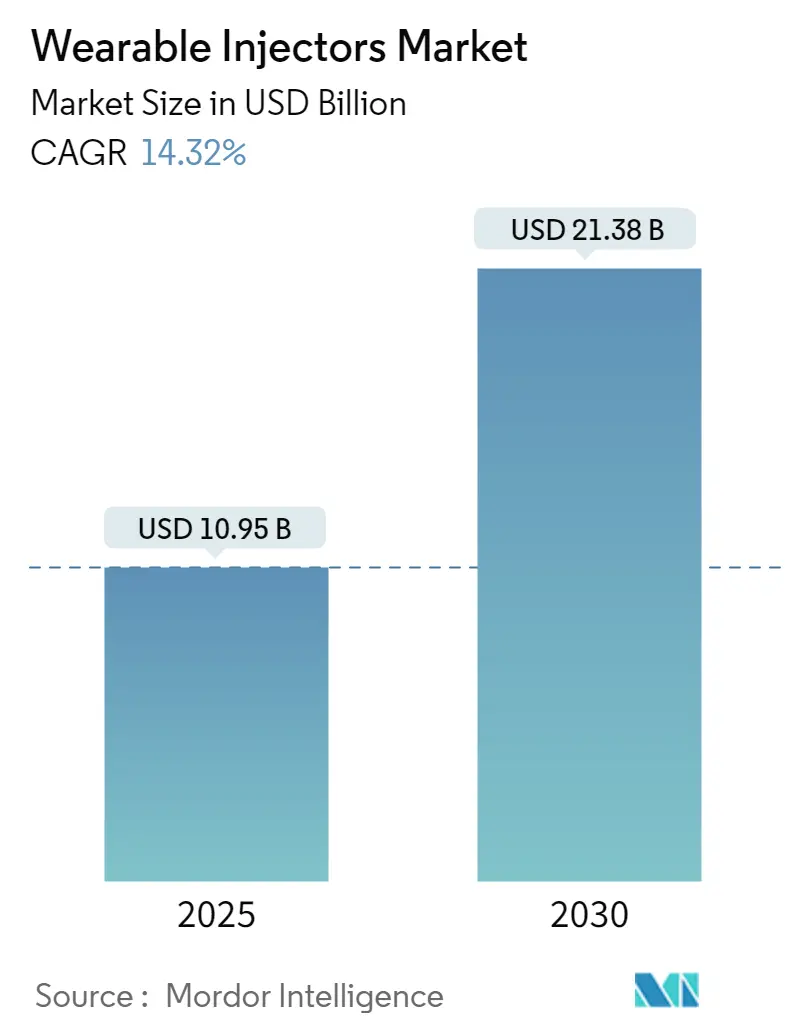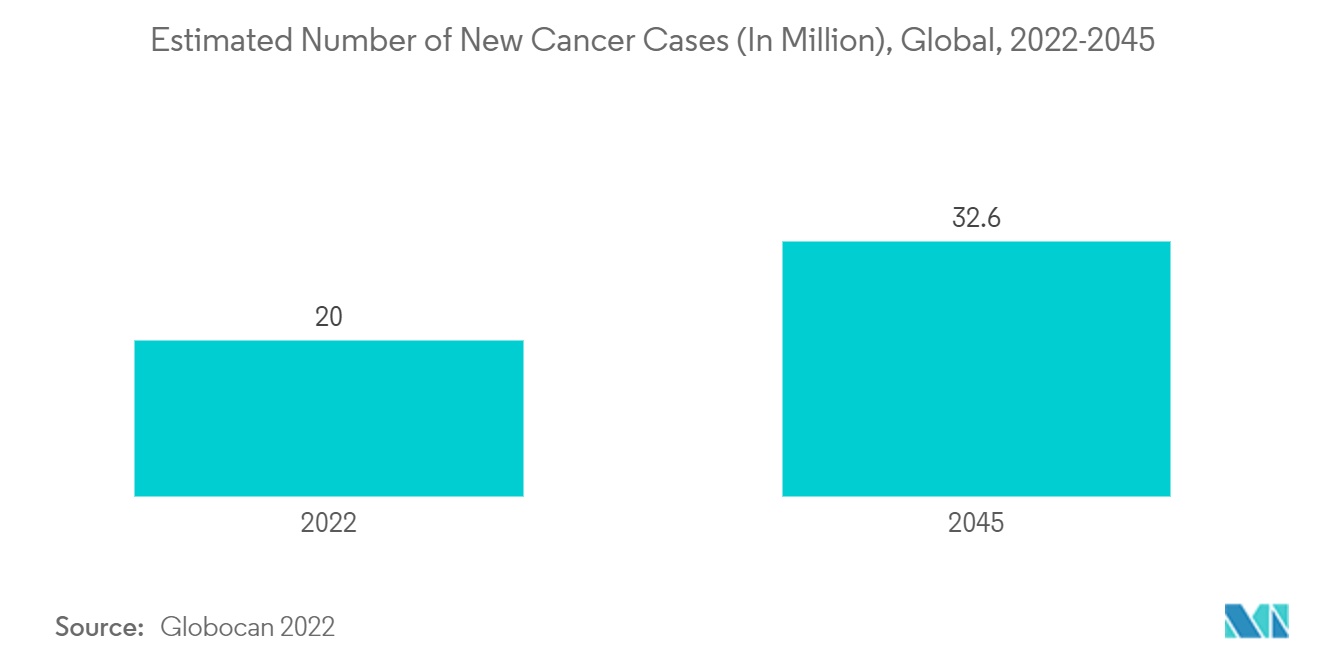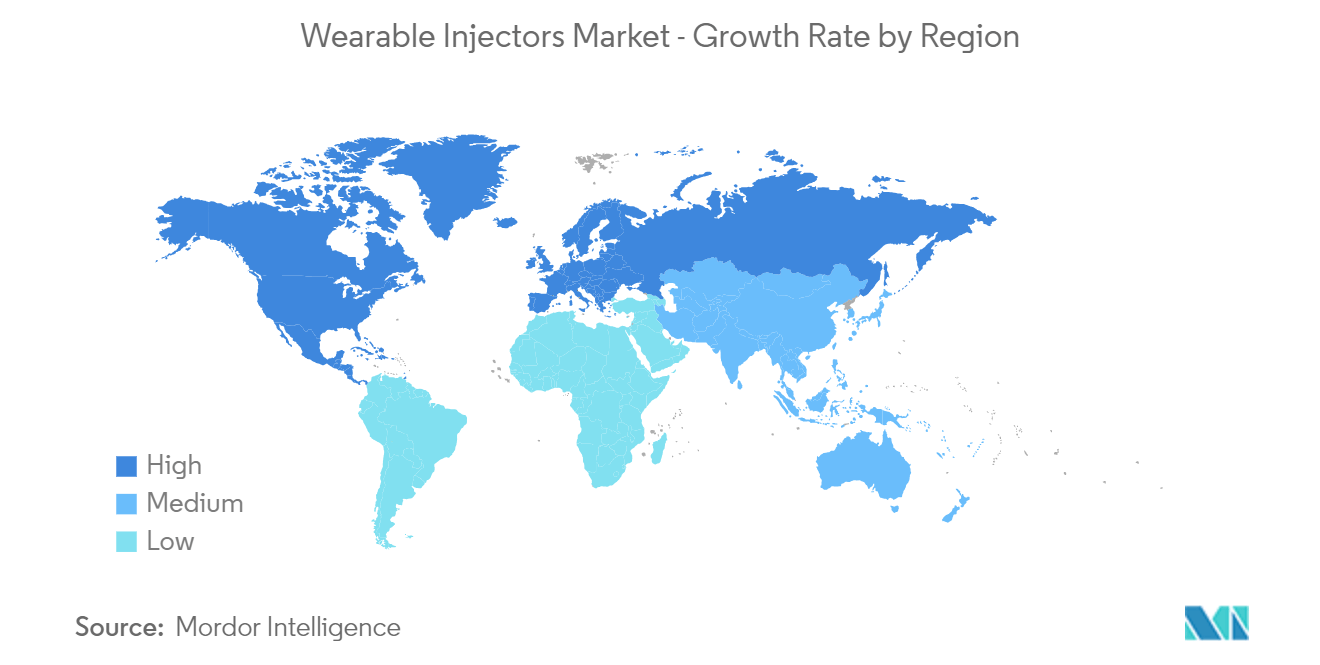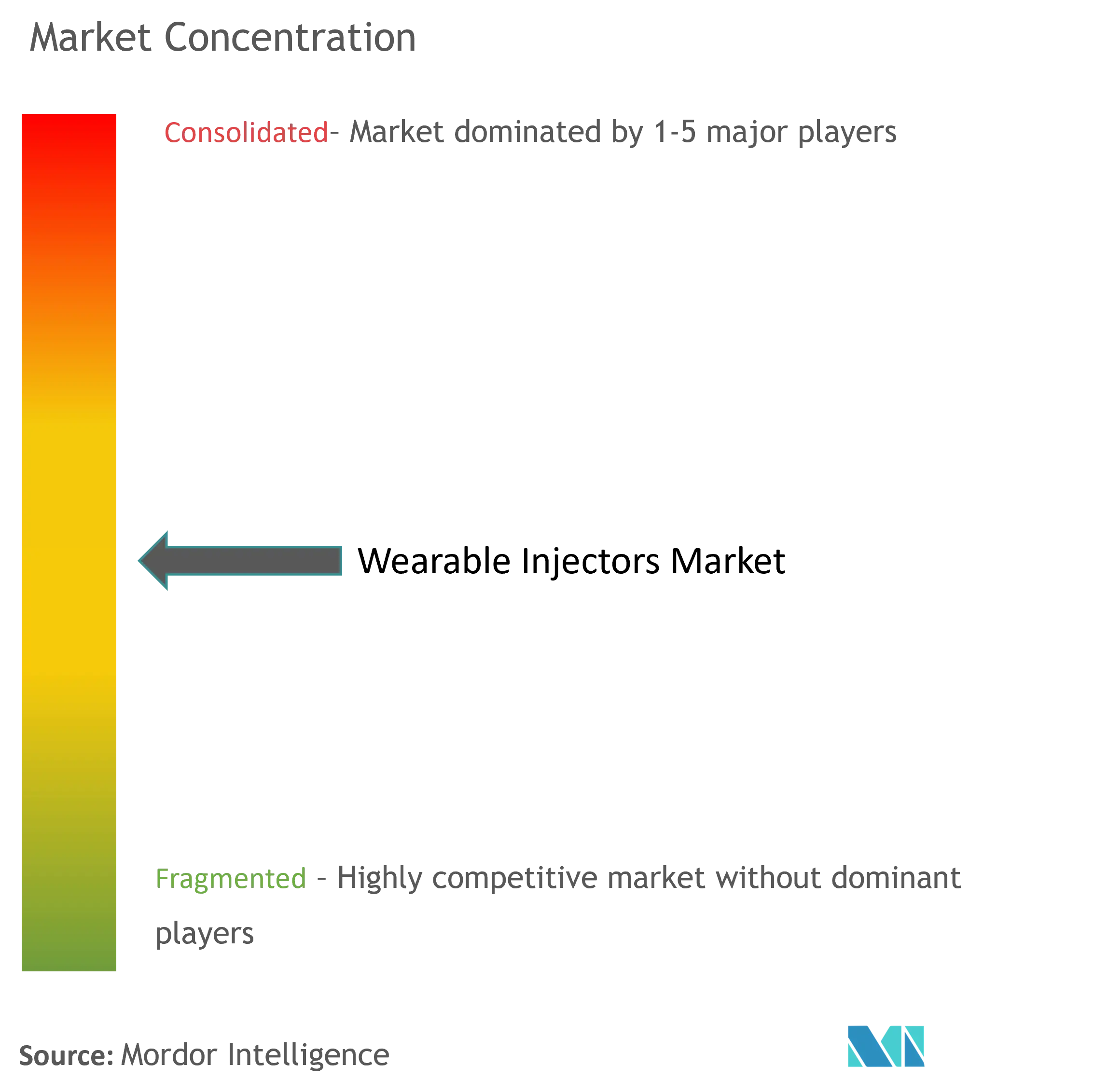Wearable Injectors Market Analysis
The Wearable Injectors Market size is estimated at USD 10.95 billion in 2025, and is expected to reach USD 21.38 billion by 2030, at a CAGR of 14.32% during the forecast period (2025-2030).
- The wearable injectors market is undergoing rapid transformation, driven by its potential to revolutionize drug delivery systems, especially for chronic disease management. These devices, designed to deliver high-volume medications subcutaneously over an extended period, offer enhanced convenience and reduce the need for frequent healthcare visits. The market's growth is primarily fueled by the rising prevalence of chronic diseases, continuous advancements in medical technology, and a growing awareness of the risks associated with traditional needle-based injections.
Enhanced Patient Compliance and Improved Outcomes
- Self-administration Benefits: The adoption of wearable injectors is significantly influenced by their ability to improve patient compliance and outcomes. These devices enable self-administration of drugs, which is particularly beneficial for managing conditions like diabetes, cancer, and autoimmune diseases, where regular and precise medication administration is critical.
- Smart Technology Integration: The integration of smart technology in wearable injectors has opened new opportunities for remote patient monitoring. This advancement not only supports better adherence to treatment protocols but also allows healthcare providers to intervene promptly when necessary.
- Market Opportunities: These technological advancements are creating substantial market opportunities, with the potential to enhance patient autonomy, reduce healthcare costs, and improve overall treatment outcomes.
- User Experience: The user-friendly design and ease of use of wearable injectors make them appealing to a broader patient population, further driving their adoption.
Growing Adoption Due to the Rise in Chronic Diseases
- Chronic Disease Burden: The escalating global burden of chronic diseases, such as diabetes, cardiovascular diseases, and cancer, is a significant factor propelling the wearable injectors market. These conditions require consistent and long-term medication regimens, making wearable injectors an ideal solution for patients needing regular drug administration at home.
- Aging Population: With the global population aging, the prevalence of chronic conditions is expected to rise, further driving the demand for wearable drug delivery systems. These devices enhance patient autonomy and reduce dependency on healthcare facilities, contributing to lower overall healthcare costs.
- Widespread Adoption: The convenience and effectiveness of wearable injectors are leading to their widespread adoption among patients and healthcare providers. The ability to administer high-volume biologics with minimal discomfort is a key advantage, particularly in managing complex and chronic conditions.
- Global Market Impact: The market's expansion is anticipated to continue, driven by the growing need for patient-centric drug delivery solutions that support long-term treatment adherence.
Technological Advancements Enhancing Device Efficiency
- Smart Wearable Injectors: Technological innovations in wearable injectors are significantly enhancing their functionality, safety, and user-friendliness. The development of smart wearable injectors that can communicate with mobile devices for real-time monitoring represents a major breakthrough in the market.
- Automated Features: Recent advancements include automated needle insertion, programmable delivery rates, and integrated sensors that provide feedback on device performance. These features make wearable injectors more accessible and appealing to a broader patient population, contributing to market growth.
- Material and Design Improvements: Ongoing research and development activities are focused on improving the design and materials used in wearable injectors. The goal is to make devices more compact, comfortable, and capable of delivering a wider range of medications, including those with high viscosity.
- Market Growth: As technological advancements continue to enhance device efficiency, the wearable injectors market is positioned for substantial growth. The integration of advanced technology and the increasing prevalence of chronic diseases underscore the market's potential.
Wearable Injectors Market Trends
Oncology Segment is Expected to Hold Significant Market Share Over the Forecast Period
- Oncology Adoption: The wearable injectors market is experiencing rapid expansion, with the oncology segment playing a crucial role. Cancer patients benefit from wearable injectors due to their ability to reduce disease progression and alleviate pain. These devices enable at-home treatment, improving patient comfort and adherence to therapy.
- Global Cancer Burden: The increasing global cancer burden significantly impacts the wearable injectors market. With countries like India and China anticipating millions of new cancer cases annually, the demand for advanced drug delivery systems like wearable injectors is expected to soar.
- Technological Innovations: The oncology segment's growth is further fueled by ongoing product innovations and technological advancements. For example, BD's Libertas Wearable Injector, designed for high-viscosity biologics, offers significant potential for cancer therapy, enhancing treatment effectiveness and patient experience.
- Positive Market Outlook: The market outlook for wearable injectors in oncology remains strong, driven by continuous R&D activities, favorable reimbursement policies, and the adoption of personalized medicine. This trend highlights the critical role of wearable injectors in modern oncology care.
North America is Expected to Hold a Significant Share in the Market and is Expected to do the Same in the Forecast Period
- Market Leadership: North America leads the wearable injectors market, a trend expected to persist due to its advanced healthcare infrastructure, high investment in healthcare technology, and the prevalence of chronic diseases requiring regular medication.
- Chronic Disease Impact: The rising incidence of chronic conditions like cancer and diabetes significantly boosts the demand for wearable injectors in North America. With millions of new cancer cases and a substantial diabetic population, the region's need for efficient drug delivery methods is evident.
- Strategic Initiatives: The North American market is characterized by numerous strategic initiatives, including product launches, mergers, and collaborations. For instance, the launch of CeQur Simplicity, a wearable insulin injector, exemplifies the region's commitment to innovation in wearable drug delivery systems.
- Government Support: Market growth in North America is also bolstered by favorable government policies and a supportive regulatory environment. The U.S. FDA's fast-track approval process for breakthrough medical devices accelerates the introduction of new wearable injectors, enhancing the region's market potential.
Wearable Injectors Industry Overview
- Moderately Consolidated Market: The wearable injectors market is moderately consolidated, with several large global companies holding significant shares. Conglomerates and specialized medical device companies dominate the market, focusing on innovation and product development.
- Prominent Players: Major players in the wearable injectors market include Becton, Dickinson and Company, Insulet Corporation, Ypsomed, Tandem Diabetes Care, Inc., and Amgen. These companies are recognized for their strong R&D capabilities, driving product innovation and expanding market presence.
- Patient-Centric Designs: Trends in the wearable injectors market include a shift toward more patient-centric designs and increased integration of digital health technologies. Companies are focusing on developing devices that are effective, convenient, and easy to use, improving patient compliance.
- Future Success Strategies: Continued innovation in device design, the integration of connectivity features for better patient monitoring, and expanding access to emerging markets are likely to be key success factors in the wearable injectors market. The industry's competitive landscape is expected to evolve, with major players driving the market forward through technological advancements and strategic initiatives.
Wearable Injectors Market Leaders
-
Becton, Dickinson and Company
-
Insulet Corporation
-
Ypsomed
-
Tandem Diabetes Care, Inc.
-
Amgen
- *Disclaimer: Major Players sorted in no particular order
Wearable Injectors Market News
- In April 2024, Ypsomed partnered with ten23 Health, a globally recognized Swiss contract development and manufacturing organization. This collaboration aims to propel the commercialization of the YpsoDose wearable injector, designed for subcutaneous self-injection of large-volume doses.
- In September 2023, Enable Injections, Inc. secured FDA approval for its EMPAVELI wearable injector (enFuse). This device facilitates the subcutaneous delivery of EMPAVELI (pegcetacoplan). Apellis Pharmaceuticals, Inc. markets EMPAVELI in the U.S. for adults diagnosed with paroxysmal nocturnal hemoglobinuria (PNH).
Wearable Injectors Industry Segmentation
As per the scope of the report, wearable injectors are delivery systems that adhere to the body to deliver larger volumes (more than 2 mL) of drug subcutaneously over an extended period. The performance of the device is not to be impacted by the patient's posture or movement.
The wearable injectors market is segmented by type, therapy, end user, and geography. By type, the market is segmented into on-body injectors and off-body injectors. By therapy, the market is segmented into oncology, autoimmune disease, diabetes, cardiovascular disease, and others. By end-user, the market is segmented into hospitals and clinics, home care, and others. By geography, the market is segmented into North America, Europe, Asia-Pacific, the Middle East and Africa, and South America. The market report also covers the estimated market sizes and trends for 17 different countries across major regions globally. The report offers the value (USD) for the above segments.
| By Type | On-Body Injectors | ||
| Off-Body Injectors | |||
| By Therapy | Oncology | ||
| Autoimmune Disease | |||
| Diabetes | |||
| Cardiovascular Disease | |||
| Others | |||
| By End User | Hospitals and Clinics | ||
| Home Care | |||
| Others | |||
| Geography | North America | United States | |
| Canada | |||
| Mexico | |||
| Europe | Germany | ||
| United Kingdom | |||
| France | |||
| Italy | |||
| Spain | |||
| Rest of Europe | |||
| Asia-Pacific | China | ||
| Japan | |||
| India | |||
| Australia | |||
| South Korea | |||
| Rest of Asia-Pacific | |||
| Middle East and Africa | GCC | ||
| South Africa | |||
| Rest of Middle East and Africa | |||
| South America | Brazil | ||
| Argentina | |||
| Rest of South America | |||
Wearable Injectors Market Research FAQs
How big is the Wearable Injectors Market?
The Wearable Injectors Market size is expected to reach USD 10.95 billion in 2025 and grow at a CAGR of 14.32% to reach USD 21.38 billion by 2030.
What is the current Wearable Injectors Market size?
In 2025, the Wearable Injectors Market size is expected to reach USD 10.95 billion.
Who are the key players in Wearable Injectors Market?
Becton, Dickinson and Company, Insulet Corporation, Ypsomed, Tandem Diabetes Care, Inc. and Amgen are the major companies operating in the Wearable Injectors Market.
Which is the fastest growing region in Wearable Injectors Market?
Asia Pacific is estimated to grow at the highest CAGR over the forecast period (2025-2030).
Which region has the biggest share in Wearable Injectors Market?
In 2025, the North America accounts for the largest market share in Wearable Injectors Market.
What years does this Wearable Injectors Market cover, and what was the market size in 2024?
In 2024, the Wearable Injectors Market size was estimated at USD 9.38 billion. The report covers the Wearable Injectors Market historical market size for years: 2019, 2020, 2021, 2022, 2023 and 2024. The report also forecasts the Wearable Injectors Market size for years: 2025, 2026, 2027, 2028, 2029 and 2030.
Our Best Selling Reports
Wearable Injector Industry Report
Our comprehensive industry research on the wearable injectors market provides an in-depth analysis of the dynamic forces driving this rapidly evolving sector. The report covers key factors such as the rise of wearable drug delivery systems, the integration of smart wearable injectors technology, and the growing demand for patient-centric solutions in chronic disease management. Stakeholders will benefit from detailed insights into market trends, competitive landscape analysis, and the latest innovations shaping the future of the wearable injectors industry. The industry report offers a thorough overview of market segmentation, including the adoption of on-body injectors and self-injection devices, making it an essential resource for strategic decision-making.
The report pdf is designed to offer stakeholders a clear and actionable understanding of the wearable injectors market, providing industry statistics, market forecasts, and an analysis of market opportunities. With a focus on industry growth and technological advancements, the report delivers valuable market data and predictions that support informed decision-making and strategic planning. Whether you're looking for an industry overview or a deep dive into market leaders and emerging trends, our industry research equips you with the information needed to navigate and succeed in the wearable injectors market.
Statistics for the 2024 Wearable Injector market share, size and revenue growth rate, created by Mordor Intelligence™ Industry Reports. Wearable Injector analysis includes a market forecast outlook to 2029 and historical overview. Get a sample of this industry analysis as a free report PDF download.






